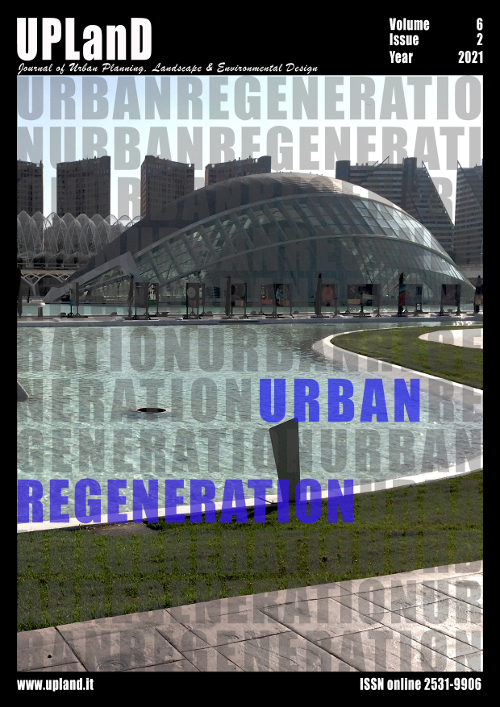Promoting urban and enviromental regeneration: a summary and comparison of two water projects
Main Article Content
Abstract
This paper is a summary of two design projects, awarded to and carried out by a research group within the Department of Architecture and Urban Studies, Politecnico di Milano (Scientific Director, Professor Michele Ugolini), following a Call for Tenders in the territory of the Lombardy region, financed by the Cariplo Foundation.
Starting from different perspectives and contexts, the projects find a common matrix in enhancing the environmental potential of a territory through the recognition of ecological corridors, rivers, parks and protected areas as a new connective system of territorial relations, in the containment of land consumption, in proposing and redesigning a sustainable mobility network, and in emphasizing the historical characteristics of the landscape as essential elements of identity.
Multifunctionality, interdisciplinarity and transcalarity are the keys to understanding the two projects that revolve around the theme of water.
The watercourse which, due to its intrinsic nature, develops linearly, is ultimately perceived as an opportunity to interpret a vast territory. The two-fold project, which bases its strategy on a conspicuous cognitive framework of the territory, does not limit itself to following the prevailing direction of a river’s length, but extends the area of intervention to the portions of territory with which it interacts, directly or indirectly.
Downloads
Article Details

This work is licensed under a Creative Commons Attribution-NonCommercial-NoDerivatives 4.0 International License.
Authors who publish with this journal agree to the following terms:- Authors retain copyright and grant the journal right of first publication with the work simultaneously licensed under a Creative Commons Attribution License that allows others to share the work with an acknowledgement of the work's authorship and initial publication in this journal.
- Authors are able to enter into separate, additional contractual arrangements for the non-exclusive distribution of the journal's published version of the work (e.g., post it to an institutional repository or publish it in a book), with an acknowledgement of its initial publication in this journal.
- Authors are permitted and encouraged to post their work online (e.g., in institutional repositories or on their website) prior to and during the submission process, as it can lead to productive exchanges, as well as earlier and greater citation of published work (See The Effect of Open Access).
References
Bassolino, E., D’Ambrosio, V., & Sgobbo, A. (2021). Data Exchange Processes for the Definition of Climate-Proof Design Strategies for the Adaptation to Heatwaves in the Urban Open Spaces of Dense Italian Cities. Sustainability, 13(10), 5694. doi: 10.3390/su13105694
Benedict, M. A., & McMahon E. T. (2006). Green infrastructure. Linking Landscapes and Communities. Washington, Covelo, London: Island Press.
Bonvesin De La Riva & Chiesa, P. (1998). De magnalibus Mediolani. Meraviglie di Milano. Milano: Libri Scheiwiller.
Clement, G. (2005). Manifesto del terzo paesaggio. Roma: Quodlibet.
Clemente, M. (2017). Re-design dello spazio pubblico. Milano: Franco Angeli.
Committee on Facilitating Interdisciplinary Research, Committee on Science, Engineering, and Public Policy, (2004). Facilitating interdisciplinary research. Washington: The National Academies.
Corboz, A. (2001). Le territoire comme palimpseste et autres essais. Besancon: Editions del’imprimeur.
Dodaro, G., & Battisti, C. (2019). I contratti di fiume: un’opportunità per una gestione migliore dei territori fluviali, in Reticula n. 22. ed. ISPRA.
Ellis, J. B. (2013). Sustainable surface water management and green infrastructure in UK urban catchment planning. Journal of Environmental Planning and Management, 56(1), 24-41.
Ercolini, M., (2007). Difesa del suolo e progettazione del paesaggio fluviale, tra esigenze e opportunità, in: Ferrara G., Rizzo G.G., Zoppi M. (Eds.), Paesaggio: didattica, ricerche e progetti. 1997-2007. Firenze University Press, Firenze. doi: 10.26530/OAPEN_345471
Fondazione Cariplo (2010), www.spaziaperti.fondazionecariplo.it/public/spaziaperti/introduzione/lcchange.php, ultimo accesso 4/11/22.
Gasparrini, C. (2018). Infrastrutture verdi e blu. Una priorità nazionale per la pianificazione urbanistica e la coesione territoriale nei prossimi anni. Urbanistica Informazioni, 282, 45.
Jongman, R.H.G., & Pungetti, G. (2004). Ecological Networks and Greenways. Cambridge: University Press.
Ministero della Transizione Ecologica (2022). Piano per la Transizione Ecologica, https://www.mite.gov.it/pagina/piano-la-transizione-ecologica, ultimo accesso: 4/11/22.
Munafò, M. (Ed.) (2021). Consumo di suolo, dinamiche territoriali e servizi ecosistemici. Edizione 2021. Report SNPA 22/21
Nyka, L. (2007). Water for Urban Strategies. Weimar: Verlag der Bauhaus-Universität.
Picon, A. (2005). Constructing Landscape by Engineering Water. In Adam H., Landscape architecture in mutation: essays on urban landscapes. Zurigo: Verlag.
Pizziolo, G. (2007). Il Fiume, segno e generatore di paesaggio. Ri-Vista. Research for Landscape Architecture, 7(1), 5-12.
Prominski, M. (Ed.) (2012). River, Space, Design: Planning Strategies, Methods and Projects for Urban Rivers. Basel: Birkhauser.
Rigillo, M. (2016). Infrastrutture verdi e servizi eco-sistemici in area urbana: prospettive di ricerca per la progettazione ambientale. TECHNE, Journal of Technology for Architecture and Enviroment, 11, 59-65.
Sansoni, G. (1996). Linee guida della relazione “Norme di buona manutenzione per fossi e piccoli corsi d’acqua”, In Atti del Convegno Gestione idraulica dei corsi d’acqua e tutela della fauna ittica, Provincia di Padova, Assessorato alla Pesca, Padova
Sansoni, G. (1998). Elementi di progettazione ambientale dei lavori fluviali. Biologia Ambientale, 12(2).
Sgobbo, A. (2018). Water Sensitive Urban Planning: approach and opportunities in Mediterranean metropolitan areas. Roma, IT: INU Edizioni
Shannon, K. (Ed.) (2008). Water Urbanisms. Ufo: Urbanism Fascicles OSA 1. Amsterdam: SUN.
Shannon, K. & SMETS, M. (2010). The Landscape of Contemporary Infrastructure. Rotterdam: NAi Publishers.
Todaro, V. (2010). Reti ecologiche e governo del territorio. Milano: Franco Angeli.
Valbonesi, E. (2015). Il valore del capitale naturale. Ecoscienza, 1, 3.
Waldheim. C. (2006). The Landascape Urbanism Reader. New York: Princeton Architectural Press.
Wolters, H.A., Platteeuw, M., & Schoor, M.M. (2001). Guidelines for rehabilitation and management of floodplains - Ecology and safety combined, IRMA NCR (Netherlands Centre for River studies), RIZA Institute - 151 152 Ministry of Transport, Public Works and Water Management, 2001.

